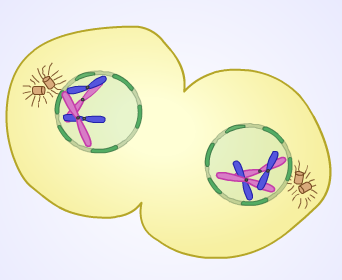Asexual Reproduction

The process by which an organism produces a new, genetically identical organism without the use of gametes. Ex: binary fissions, runners in plants, budding and regeneration.
Chromosome

A single long molecule of DNA wound around proteins called histones.
Genes

Segments of DNA that code for 1 protein/trait.
Sister Chromatids

One of the two identical strands in a replicated chromosome.
Cell Cycle

The series of events that take place in a cell during its lifetime.
Phases:
- Interphase
- Mitosis
- Cytokinesis
Interphase

Period of cell cycle where cell grows and develops and DNA replicates.
Centromere

The point in the chromosome at which two chromatids are joined.
Mitosis

Stage of cell cycle when the nucleus divides.
Phases:
- Prophase
- Metaphase
- Anaphase
- Telophase
Spindle Fibers

Microtubules that pull the sister chromatids apart during mitosis.
Prophase

1st stage of mitosis
- Nuclear envelope breaks down
- Chromosomes condense
- Spindle fibers start to form
Metaphase

2nd stage of mitosis
- Chromosomes line up at the equator or middle of the cell
- Spindle fibers attach to the centromeres
Anaphase

3rd stage of mitosis
- Spindle fibers pull sister chromatids apart to opposite sides of the cell.
Telophase

Last stage of mitosis
- Nuclear envelope reforms around separated chromosomes
- Chromosomes uncondense
- Spindle fibers break down
Cytokinesis

After mitosis
Rest of cell divides to get 2 individual cells.
Cell Differentiation

The process of cell modification to form specialized cells. Certain genes on the DNA are turned on or off.
Stem Cells

Cells that are undifferentiated that are capable of becoming specialized cells.
Daughter cells

The resulting identical cells after cell division
Somatic Cell

Body Cells - Any cell that forms in the body of the organism.
DNA Replication

Process that makes an exact copy of DNA. Uses both strands as templates.
Semi-conservative Replication

After DNA replication, the resulting DNA has 1 original strand and 1 new strand. This is due to using both strands of original DNA as templates and ensures the accuracy of the replication.